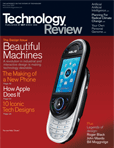|
Tuesday, May 08, 2007 Audio Menus for iPodsContinued from page 1 By Kate Greene
EarPod was designed specifically for gadgets with circular touch pads, says Baudisch. The circular touch pad is evenly divided into eight sectors: it's cut like pieces of a pie, with each menu item associated with each piece. When a person touches the dial of an earPod-equipped gadget, the audio menu responds with a prerecorded human voice. If a person puts his or her finger at 12 o'clock on the touch pad, the voice might say "Color," indicating that the finger is on the color sector. When the finger crosses one of these invisible sector lines, the user hears a clicking sound. As a finger moves, a new menu item is announced. To select an item and go to the next menu level, the user lifts his or her finger and hears a "camera-shutter" sound, which indicates that an item has been chosen. Because the touch pad is divided into portions, says Baudisch, people can easily learn where menu items are and quickly jump to certain items without having to scroll through a list, as with an iPod. Another feature of earPod, he says, is that a user doesn't need to wait until a menu item is read before moving on to another. When a finger moves to a new sector, the audio is interrupted and the new item is announced. In the earPod usability study, conducted by Shengdong Zhao, a doctoral student at the University of Toronto, and project lead, the researchers found that people who had no experience using either an iPod or an earPod-equipped device used the devices with equal accuracy. EarPod was 92.1 percent accurate, while the visual system was 93.9 percent accurate, but the difference was not statistically significant. It took people longer to grow accustomed to earPod, but with experience, users' performance on the audio menu became faster. After 30 minutes of training on both devices, subjects could navigate two levels of menu with earPod in 2.1 seconds as opposed to 2.5 seconds with the visual menu. Georgia Tech's Walker is impressed with the earPod approach and results. "My overall impression is that this is great ... It was inevitable: trying to look at how to take an interface that is purely visual on the iPod and turn it into an interface that's purely auditory, because, after all, the iPod's an auditory device. Why should a person have to pull their player out while they're jogging to look at it?" Currently, however, earPod could not be a complete replacement for an iPod menu, Walker notes. One reason is that earPod doesn't lend itself to menu flexibility. Once a person learns the position of the menu items, he or she might become frustrated if those positions need to change due to a software update or added playlist. In particular, the approach would not work well for menus such as mobile-phone address books, Walker says. In addition, adds Baudisch, because the circular track pad is divided into sectors, there are a limited number of menu items that a person can access. If there are 8 sectors, each with 8 menu items, then there are only 64 total items accessible on the device, and this wouldn't be good enough for iPods that hold hundreds of playlists and thousands of songs. However, Baudisch suspects that future prototypes will provide ways to get around the problem. He and his team are exploring how people respond to faster audio output (speeding up the recorded voice) and how people use audio and visual cues simultaneously. Developing an all-encompassing interface for eyes-free operations on auditory devices is still a future project, he says. |
 |
||||||
|
||||||

 Add to Facebook
Add to Facebook



Comments